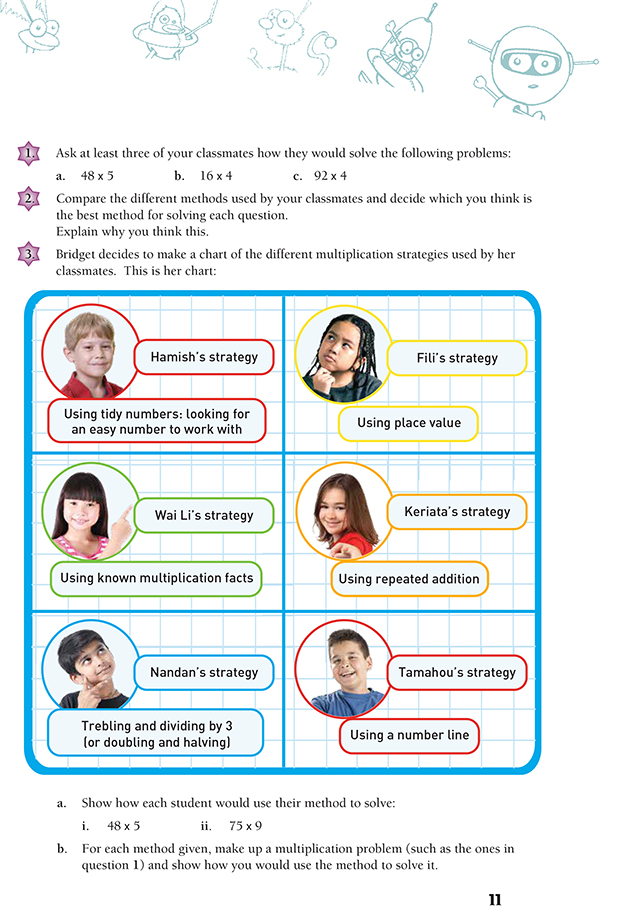This is a level 4 number activity from the Figure It Out series. It relates to Stage 7 of the Number Framework.
A PDF of the student activity is available.
Click on the image to enlarge it. Click again to close. Download PDF (349 KB)
use mental strategies to solve multiplication problems
FIO, Level 3, Number, Book 2, Multiple Methods, pages 10-11
A classmate
This activity presents multiplication strategies from the early additive stage through to advanced multiplicative thinking.
Have the students attempt to solve the opening scenario mentally and then compare their strategies with those shown in the speech bubbles. Direct them to Bridget’s chart in question 3 that classifies the strategies. This chart is a useful way to describe the strategies.
Note that Nandan’s strategy, where 3 x 27 is seen as 9 x 9, may need special attention. This can be explained in two ways:
• Partitioning numbers into factors.
3 x 27 = 3 x (9 x 3) can be regrouped as (3 x 3) x 9 = 9 x 9.
• Multiplying one factor (3) by 3 and dividing the other (27) by 3.
This is an extension of the more common doubling and halving strategy.
Note the difference in thinking between the strategies that partition numbers additively and those that use factors to split numbers into easier steps. The efficiency of strategies can be looked at from two perspectives. Firstly, they are efficient if they provide a quick and easy way to get the correct answer. Secondly, there is a qualitative difference between those students who can split numbers only by adding or subtracting and those who can use factors as well as adding or subtracting. This
second way provides more options for the problem solver, both with a particular problem and with the development of more advanced thinking.
Students in transition to the advanced multiplicative stage of thinking will be using factors to split multiplication and division for at least a part of the calculation.
Activity
1. Strategies will vary.
a. Some possible strategies for 48 x 5 are:
(48 x 10) ÷ 2
(40 x 5) + (8 x 5)
(50 x 5) – (2 x 5)
24 x 10
48 + 48 + 48 + 48 + 48
50 + 50 + 50 + 50 + 50 – 10
b. Some possible strategies for 16 x 4 are:
8 x 8
(4 x 10) + (4 x 6)
(4 x 15) + 4
(4 x 20) – (4 x 4)
c. Some possible strategies for 92 x 4 are:
(4 x 100) – (4 x 8)
(92 x 2) then x 2 again. (92 x 2 x 2)
92 + 92 + 92 + 92
(90 x 4) + (2 x 4)
2. Answers will vary.
3. a. Answers may vary. For 48 x 5, the 6 methods
could be:
i. Hamish: (50 x 5) – (2 x 5).
(Tidy numbers)
Fili: (40 x 5) + (8 x 5).
(Place value)
Wai Li: (48 x 10) ÷ 2.
(Known multiplication facts)
Keriata: 48 + 48 + 48 + 48 + 48.
(Repeated addition)
Nandan: 24 x 10.
(Doubling and halving)
Tamahou: A possible number line is:
ii. For 75 x 9, the 6 methods could be:
Hamish: 75 x 10 – 75. (Tidy numbers)
Fili: (70 x 9) + (5 x 9).
(Place value)
Wai Li: (80 x 9) – (5 x 9).
(Known multiplication facts)
Keriata: 75 + 75 + 75 = 225.
225 + 225 + 225 = 675.
(Repeated addition)
Nandan: (25 x 9) x 3 (dividing and multiplying by 3) or
(25 x 10) x 3 – (25 x 3)
(dividing and multiplying by 3 and using tidy numbers)
Tamahou: A possible number line is:
b. Answers will vary.



